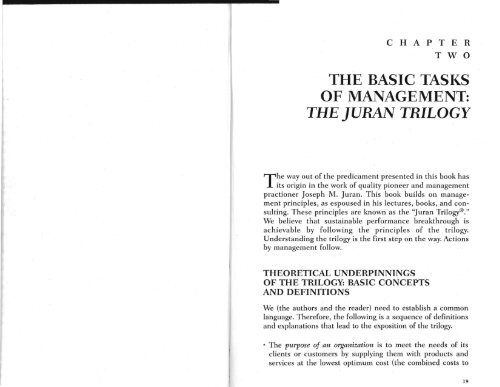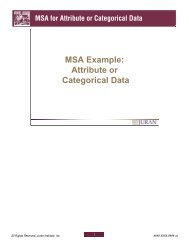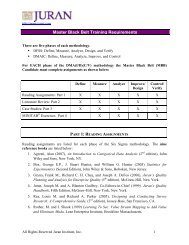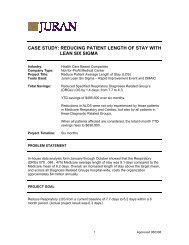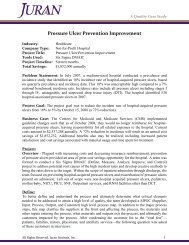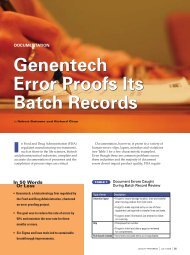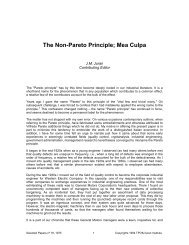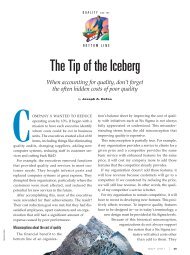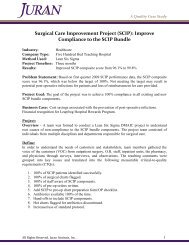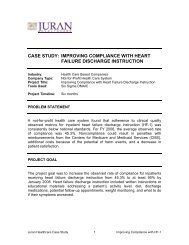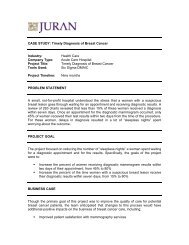Ch2 JAD Breakthrough and Beyond.pdf - Juran Institute
Ch2 JAD Breakthrough and Beyond.pdf - Juran Institute
Ch2 JAD Breakthrough and Beyond.pdf - Juran Institute
Create successful ePaper yourself
Turn your PDF publications into a flip-book with our unique Google optimized e-Paper software.
CHAPTER<br />
TWO<br />
THE BASIC TASKS<br />
OF MANAGEMENT:<br />
THE JURAN TRILOGY<br />
The way out of the predicament presented in this book has<br />
its origin in the work of quality pioneer <strong>and</strong> management<br />
practioner Joseph M. <strong>Juran</strong>. This book builds on management<br />
principles, as espoused in his lectures, books, <strong>and</strong> consulting.<br />
These principles are known11S the "<strong>Juran</strong> Trilogy®."<br />
We believe that sustainable performance breakthrough is<br />
achievable by following the principles of the trilogy.<br />
Underst<strong>and</strong>ing the trilogy is the first step on the way. Actions<br />
by management follow.<br />
THEORETICAL UNDERPINNINGS<br />
OF THE TRILOGY: BASIC CONCEPTS<br />
AND DEFINITIONS<br />
We (the authors <strong>and</strong> the reader) need to establish a common<br />
language. Therefore, the following is a sequence of definitions<br />
<strong>and</strong> explanations that lead to the exposition of the trilogy.<br />
• The purpose of an organization is to meet the needs of its<br />
clients or customers by supplying them with products <strong>and</strong><br />
services at the lowest optimum cost (the combined costs to<br />
19
20 CHAPTER Two<br />
THE BASIC TASK OF MANAGEMENT: THE JURAN TRILOGY 21<br />
the supplier <strong>and</strong> customer). All organizational <strong>and</strong> individual<br />
performance is dedicated to that end (or should be).<br />
• Products can be hard goods, services (work done for someone<br />
else), or information (data, software, etc.). Products are produced<br />
by means of processes.<br />
• A process is a sequence of tasks or events that creates an output-a<br />
product: goods, services, or information. Processes<br />
include everything involved in each step: people, techniques,<br />
software, machines, tools, raw materials, facilities, procedures,<br />
management practices, etc.<br />
• A customer is one who receives the output of a process or any<br />
step in the process. A client is a special kind of customer who<br />
pays for what is received. Customers do not necessarily pay,<br />
although they may. There are two basic types of customers:<br />
external (located outside of your organization) <strong>and</strong> internal<br />
(located within your organization). Each type of customer has<br />
needs that must be met if the organization is to serve its purpose.<br />
Usually, in a world-class organization, meeting the<br />
needs of internal customers is a prerequisite for being able to<br />
meet the needs of external customers. Management must<br />
devote its energy to meeting both sets of needs, with equal<br />
vigor <strong>and</strong> dedication.<br />
• A high-quality product is one that meets the needs of its customers<br />
at the lowest cost (minimum waste <strong>and</strong> maximum consistency).<br />
Quality is measured by determining the extent to<br />
which these two criteria are met. Observing the two possible<br />
characteristics of the outputs of a process-product features<br />
(good characteristics) <strong>and</strong> deficiencies (bad characteristics)<br />
makes this determination. It follows that the job of managers<br />
(leaders) is to produce high-quality products by putting in<br />
place all the necessary means to do this. The necessary means<br />
are described in the principles of the trilogy.<br />
• Process outputs can embody both product features <strong>and</strong> deficiencies.<br />
• Product features are the characteristics, or properties, of a<br />
product that meet specific needs of specific customers. For a<br />
person who purchases an automobile for personal use, the<br />
needs are the benefits sought from the automobile: transportation,<br />
style, status, <strong>and</strong> comfort. The associated product<br />
features are what specifically about the product meets each<br />
need. For the needs just listed, the product features may be a<br />
capacity of six passengers, power, top speed, acceleration,<br />
range, aerodynamic design, price, leather bucket seats, <strong>and</strong><br />
premier sound system. For a patient in a hospital, desired<br />
benefits (needs) may include quick admission, comfortable<br />
bed, <strong>and</strong> curing the ailment. The associated (service) features<br />
might be pre-admission by phone in advance of checking in,<br />
scientifically designed power-adjustable bed, <strong>and</strong> a recovery<br />
with no infection, no relapse, <strong>and</strong> no repeated treatment.<br />
Product features are what make the customer happy <strong>and</strong> give<br />
satisfaction. Product features are what produce sales <strong>and</strong><br />
repeat dem<strong>and</strong>.<br />
• Deficiencies are things that are wrong with the product-or<br />
the process. Examples of deficiencies are specific defects,<br />
excessive time cycles, <strong>and</strong> excessive costs. Defects include<br />
errors, omissions, the need for reworking or scrapping a product,<br />
etc. Defects make customers unhappy <strong>and</strong> produce dissatisfaction.<br />
Defects result in a loss of profitability because of<br />
the costs of poor quality (unnecessary waste) that eat into the<br />
bottom line <strong>and</strong> can reduce or prevent sales.<br />
NOTE: Satisfaction <strong>and</strong> dissatisfaction are not opposites.<br />
They are separate dimensions of customer<br />
reaction. Reducing dissatisfaction does not produce satisfaction;<br />
it merely reduces dissatisfaction. Increasing<br />
satisfaction does not decrease dissatisfaction; it merely<br />
increases satisfaction. Therefore, you cannot make customers<br />
who are dissatisfied by defects in your product<br />
less dissatisfied <strong>and</strong> happier by giving them more product<br />
features.<br />
For example, you can't make people happy with their unreliable<br />
cell phone service by granting them a large amount of<br />
free air time. They'll be pleased with the free time, but they'll<br />
still be unhappy with the lousy phone service.<br />
J
22 CHAPTER Two<br />
THE BASIC TASK OF MANAGEMENT: THE JURAN TRILOGY 23<br />
The <strong>Juran</strong> Trilogy is a management system for producing<br />
ideal product features <strong>and</strong> minimum deficiencies at lowest possible<br />
costs.<br />
Following the Trilogy permits an organization to maximize<br />
customer satisfaction (by economically producing ideal product<br />
features) <strong>and</strong> minimize dissatisfaction (by reducing or eliminati,ng<br />
deficiencies <strong>and</strong> the costs of poor quality-waste-associated<br />
with deficiencies).<br />
Embedded in the Trilogy principles is the concept that work<br />
gets done; that is, products are produced by means of multifunctional<br />
processes. The production of a product is the ultimate<br />
result of inputs <strong>and</strong> outputs at each successive step in a<br />
spiral of functional activities. In manufacturing, for example,<br />
the spiral may travel through functions such as sales, design,<br />
test, procurement, storage <strong>and</strong> retrieval, production <strong>and</strong> inventory<br />
control, operations, packaging, shipping, customer service,<br />
<strong>and</strong> so on. The production process is theoretically seamless,<br />
<strong>and</strong> travels from beginning to end of the spiral <strong>and</strong> then repeats<br />
the cycle over <strong>and</strong> over.<br />
Although the spiral is seamless, in practice, it is not always<br />
observed to operate that way. When one attempts to observe<br />
organizational processes, one encounters some strange sights.<br />
One strange sight is that a typical organization is organized into<br />
a group of relatively vertical functional silos, each devoted to<br />
providing a specific organizational function: procurement,<br />
design, sales, production, transportation, trainirig, human<br />
resources, <strong>and</strong> the like. Each function has its own manager, its<br />
own budget, <strong>and</strong> its own goals. It may have its own norms <strong>and</strong><br />
customs, <strong>and</strong> its own language. People residing in a given silo<br />
look to the manager of that silo for guidance <strong>and</strong> direction, <strong>and</strong><br />
have a tendency to view their job in terms of the tasks they perform<br />
on behalf of their own function. Often, the organization<br />
reward system reinforces all this.<br />
This state of affairs is strange because the processes by<br />
which the organization's ultimate products are produced move<br />
across multiple functions. Nevertheless, it is rare to observe<br />
multifunctional management structures to control the whole<br />
process as it moves across the fiefdoms of the functional man-<br />
agers. Cost accounting prpcedures typically track functional,<br />
not multi-functional costs, even though the major costs of poor<br />
quality (waste) occur multi- or cross-functionally.<br />
One observes multi-functional processes being managed<br />
functionally! All this can result in delays, confusion, bad feelings,<br />
unreliable enmmunication, <strong>and</strong> uncoordinated activity,<br />
not to mention unnecessarily high costs <strong>and</strong> other barriers to<br />
efficiency <strong>and</strong> effectiveness. Fortunately, there is an emerging<br />
trend toward multifunctional accounting <strong>and</strong> managing, but it<br />
is by no means universal.<br />
Clearly, management has,ajob to do to untangle the organization<br />
from this disconnect between performance <strong>and</strong> structure<br />
that produces a steady stream of poor quality <strong>and</strong><br />
unnecessary waste. When managers follow the principles of<br />
the trilogy, they can do the job.<br />
THE BASIC TASKS OF MANAGEMENT<br />
According to the <strong>Juran</strong> Trilogy, management performs three<br />
basic tasks.<br />
First, it sets goals (strategic <strong>and</strong> operational goals <strong>and</strong> quality<br />
goals for products <strong>and</strong> processes), <strong>and</strong> puts in place the means<br />
to attain those goals. The process for setting organizational goals<br />
is called strategic planning <strong>and</strong> quality planning (product <strong>and</strong><br />
process design). The umbrella term "planning" is used to designate<br />
activities that are carried out in preparation for taking<br />
action. Planning establishes, among other things, specific st<strong>and</strong>ards/specifications<br />
for specific products or processes. Financial<br />
planning, a similar exercise, sets out the financial goals <strong>and</strong> the<br />
means to achieve them <strong>and</strong> results in a budget (a financial plan).<br />
Second, management prevents or corrects unwanted "bad"<br />
change. This process is known as control. More precisely, control<br />
consists of measuring actual performance, comparing it to<br />
the target or st<strong>and</strong>ard, <strong>and</strong> taking action on the (bad) difference.<br />
Control maintains the st<strong>and</strong>ards, requirements, <strong>and</strong><br />
specifications set in planning. The goals of control are stability,<br />
repeatability, <strong>and</strong> consistency.
24 CHAI)TER Two<br />
THE BASIC TASK OF MANAGEMENT: THE JURAN TRILOGY 25<br />
Third, management creates unprecedented "good" change.<br />
This process is called breakthrough. <strong>Breakthrough</strong> is a deliberate<br />
change, a dynamic, decisive movement to unprecedented<br />
higher levels of organizational performance than is currently in<br />
the plan <strong>and</strong> maintained by current controls. <strong>Breakthrough</strong><br />
results in improved st<strong>and</strong>ards <strong>and</strong> specifications.<br />
Planning, control, <strong>and</strong> breakthrough are each essential for<br />
organizational vitality, but individually they are insufficient.<br />
Therefore, managers must accomplish all three. Each arises<br />
from a specific prerequisite for organizational survival. Each<br />
fulfills a specific vital purpose <strong>and</strong> function. Each entails its<br />
own distinctive sequence of events, tools, <strong>and</strong> techniques.<br />
Each of the three interacts with the other two. Without planning,<br />
control, <strong>and</strong> breakthrough, an organization would be<br />
incapable of prolonging its existence. Put plainly, no organization<br />
can survive if these functions are not performed.<br />
In carrying out their managerial tasks of planning, control,<br />
<strong>and</strong> breakthrough, managers basically make economic decisions<br />
on behalf of the welfare of the organization. Accordingly,<br />
we will discuss the three basic managerial tasks in terms of<br />
costs, specifically the costs of unplanned waste, the so-called<br />
costs of poorly performing processes (COP3). The higher the<br />
COp3, the lower the bottom line. These costs pay for the nonvalue-added<br />
activities an organization is forced to perform<br />
when compensating for any type of deficiency. The discussion<br />
moves through the trilogy, starting with planning, then discussing<br />
control, then breakthrough.<br />
COSTS OF POORLY PERFORMING<br />
PROCESSES (COP3) AND THE TRILOGY<br />
The cumulative costs associated with poor performing products<br />
<strong>and</strong> processes can easily consume your organization's<br />
profits. A traditional common metric of poor organizational<br />
performance is the "costs of poor quality" (COPQ). COPQ are<br />
the costs of unplanned, unnecessary waste. COPQ has been<br />
used as an ad hoc financial report to quantify the losses due to<br />
poor performance. Historically, studies have shown costs of<br />
poor quality to run as high as 15 to 40 percent of costs of goods<br />
sold or about 15 to 20 percent of sales revenue, an extraordinary<br />
sum of money lost. These accumulated costs are usually<br />
not reported to management, at least not in an easily understood<br />
financial manner that would permit making decisions for<br />
countermeasures. Managers remain unaware of their full<br />
extent <strong>and</strong> impact because traditionally, calculations of costs<br />
are made by comparing overall departmental expenditures with<br />
overall departmental budgets.<br />
In this book, we want to provide an updated way to measure<br />
<strong>and</strong> think about traditional COPQ. We call this new measure<br />
"COP cubed." COp3 means "Costs of Poorly Performing<br />
Processes." It seems to be an easy way to convey the real meaning<br />
of COPQ <strong>and</strong> the purpose for calculating COPQ.<br />
Information about overall costs, as conveyed by traditional<br />
accounting reports, does not reveal enough detail to enable<br />
managers to identify specific problems <strong>and</strong> opportunities for<br />
improvement as they relate to the way work gets donethrough<br />
cross- or multi-functional processes. Furthermore, in<br />
addition to departmental activities that are carried out because<br />
of poor performance, there are numerous activities (such as<br />
repair, rework, clarifying unclear instructions, etc.) that are<br />
performed to compensate for poor quality, as processes move<br />
across <strong>and</strong> between the various departments. None of these<br />
activities would be carried out if there were no quality problems.<br />
For example, we wonder whether most of the staff in a'<br />
traditional Accounts Receivable Department would still have<br />
jobs if the reasons clients don't pay were to be discovered <strong>and</strong><br />
eliminated!<br />
NOTE: A quality problem is a specific failure to meet a<br />
specific need of a specific customer. There is no such<br />
thing as quality in general, except in the sense of the<br />
aggregate extent to which each vital need of each vital<br />
customer is met. Hence, one cannot improve quality in<br />
general. One improves upon specific failures to meet<br />
specific needs of specific customers.<br />
-J
26 CHAPTER Two<br />
THE BASIC TASK OF MANAGEMENT: THE JURAN TRILOGY 27<br />
With a COP3 analysis as a starting point, important problems<br />
are easily identified, selected for projects, <strong>and</strong> eliminated.<br />
Intra- or cross-functional activities, largely hidden from<br />
detection by traditional cost accounting systems, can be<br />
extremely expensive, adding significantly to the costs of poor<br />
quality, <strong>and</strong> reducing significantly the bottom line. A recent<br />
report provided by the Midwest Business Group on Health <strong>and</strong><br />
the <strong>Juran</strong> <strong>Institute</strong> showed that the total costs of poor quality<br />
in the United States health care system are approaching 30<br />
percent of the $1.3 trillion spent annually on health care.<br />
Organizations rarely have departmental budgets that show<br />
costs of activities in enough detail to pinpoint specific improvement<br />
opportunities. Even less common are cross- or multi-departmental<br />
budgets or measures for inter- or cross-departmental costs,<br />
such as those provided by activity-based accounting systems.<br />
Consequently, management is generally unaware of the extent of<br />
the opportunities-indeed of the necessities-for making specific<br />
improvements in performance, <strong>and</strong> therefore, they do not take<br />
place. Serious quality problems, with their associated steady but<br />
avoidable drain on resources <strong>and</strong> reputation, remain unaddressed.<br />
COPQ would all disappear if every task was always performed<br />
without deficiency. COp3 are the costs of unplanned,<br />
theoretically unnecessary waste. <strong>Breakthrough</strong> improvement<br />
can capture these costs from beginning to end of the supply<br />
chain. This would drive costs down by targeting <strong>and</strong> removing<br />
the deficiencies that caused the excess costs in the first place.<br />
There are three major categories of COp3:<br />
• Appraisal costs<br />
• Internal process failure costs<br />
• External product failure costs<br />
ApPRAISAL COSTS<br />
The portion of appraisal costs that are included in COp3 are<br />
those costs associated with discovering deficiencies before<br />
external customers are affected by them. Some of these costs<br />
may be excessive <strong>and</strong> therefore "non-value added." Appraisal<br />
costs include costs of checking <strong>and</strong> inspecting your processes<br />
<strong>and</strong> work in progress to assure that the processes are performing<br />
to st<strong>and</strong>ard, <strong>and</strong> the products meet the requirements.<br />
Examples ofAppraisal Costs<br />
---<br />
• Testing appliances before shipping<br />
• Reviewing insurance policy before mailing<br />
• Inspecting purchased equipment/supplies<br />
• Proofreading reports or cor~espondence<br />
• Auditing customer bills prior to sending bill<br />
• Testing an automobile to be certain repairs were made<br />
Note that these activities are performed because we expect<br />
to find something bad. We don't trust our suppliers or our<br />
processes, probably with good reason. The portion of inspection<br />
costs incurred to carry out routine quality control audits<br />
are not costs of poor quality. This is because these audits are<br />
supposed to occur anyway. They are part of one of the three<br />
basic managerial tasks: control. (Control is described in detail<br />
in Chapter 4, "The Control Processes.")<br />
INTERNAL PROCESS DEFICIENCY COSTS<br />
Internal process deficiency costs are the costs to repair,<br />
replace, or discard defective work that the customer does not<br />
see directly, although customer service may well be adversely<br />
affected, if the deficiencies delay delivery time. Internal deficiencies<br />
usually accumulate as a process moves from task to<br />
task, step to step. In Six Sigma, the rolled throughput yield<br />
metric is a good example of a measure of deficiency cost<br />
buildup, as shown in Figure 2.1.<br />
Examples of Internal Process Deficiency Costs<br />
• Working overtime to make up for schedule slippage<br />
• Taking another X-ray<br />
• Replacing m~tal stampings that do not meet specifications
28 CHAPTER Two<br />
THE BASIC TASK OF MANAGEMENT: THE JURAN TRILOGY 29<br />
l1ecdve Parts fro111 Sllppli(~r<br />
Examples of External Product Deficiency Costs<br />
45,000 ppm wm'''t<br />
RIY", ,955"',97" .944'" 87.4%<br />
FIGURE 2,1<br />
95.5% ¥\dd<br />
Following Hccciving<br />
.Inspection <strong>and</strong> Line F"H·Ou(.,.<br />
-----......... -!)<br />
"'ll,,~a'1j,_~<br />
Holled throughput or total process yield,<br />
• Repainting scratched surface of products<br />
• Making up for unplanned downtime<br />
Replacing products damaged during moving, packing, or<br />
shipping<br />
• Rewriting part of a proposal<br />
Correcting errors in various databases<br />
Stocking extra parts or components to replace predictably<br />
defective ones<br />
• Scrapping products that do not meet specifications<br />
• Satisfying warranty claims<br />
• Investigating <strong>and</strong> resolving complaints<br />
• Giving credits <strong>and</strong> allowances to customers<br />
• Offsetting customer dissatisfaction with a recovery strategy<br />
• Collecting bad debts<br />
• Correcting billing errors<br />
• Expediting late shipments<br />
• Replacing or repairing goods damaged or lost by carrier<br />
• Housing str<strong>and</strong>ed passengers from a canceled flight<br />
• Paying interest or losing discount for late payments<br />
• Giving onsite assistance to customers to overcome field<br />
problems<br />
• Going into litigation, due to alleged mistreatment of a patient<br />
As a cOlnpany gains H btoa(h~r dcfinitiollof poor quality,<br />
the hidden porth)'!'} of the iceberg becomes apparent;<br />
EXTERNAL PRODUCT DEFICIENCY COSTS<br />
External failures occur after the product leaves our organization<br />
or when a service is performed. These are the failures that<br />
customers, regulators, <strong>and</strong> society see <strong>and</strong> feel as a result of<br />
coming into contact with your product. They are the most<br />
expensive to correct, <strong>and</strong> they are costly in other ways as well.<br />
They result in extra costs of attempting to regain the customer's<br />
confidence, <strong>and</strong> they can easily result in a loss of customers-a<br />
cost that usually cannot be calculated.<br />
FIGURE 2.2<br />
Cost of poorly performing processes (COP3).
30 CHAPTER Two<br />
THE BASIC TASK OF MANAGEMENT: THE JURAN TRILOGY 31<br />
Note how traditional cost accounting <strong>and</strong> reporting practices<br />
"hide" many costs of poorly performing processes. Just as<br />
most of the ice in an iceberg is invisible from the surface of the<br />
water, a very large proportion of costs of poorly performing<br />
processes are absent from traditional financial reports. This<br />
invisibility may explain why so many organizations continue to<br />
tolerate such high levels of avoidable costs. In effect, they are<br />
not really tolerating them; they are simply ignorant of them.<br />
With this background, we continue our description of the<br />
three basic managerial tasks by referring to Figure 2.3, the<br />
<strong>Juran</strong> Trilogy.<br />
The vertical (Y) axis represents COp3 as a percent of revenue.<br />
Anything that goes up is bad. The horizontal (X) axis represents<br />
time marching on from time zero, at the left, when<br />
operations begin.<br />
PLANNING<br />
Starting at the left side of Figure 2.3, before time zero, strategic<br />
planning <strong>and</strong> deployment have already occurred. Quality<br />
__ Planning __I • Control (During Operations) •<br />
FIGURE 2.3<br />
40<br />
20<br />
COp3<br />
Chronic Waste<br />
LeSS0I1S Learned<br />
Time<br />
New Zone of<br />
Control<br />
t<br />
~! I~<br />
o<br />
Original Zone of<br />
Control<br />
t<br />
The <strong>Juran</strong> Trilogy.<br />
Sporadic Spike<br />
planning (product <strong>and</strong> process design) has also already been<br />
completed in preparation for operations. Quality planning<br />
establishes the design of a product that will meet customers'<br />
needs, together with the process that will produce the product.<br />
Quality planning follows a more, or less universal sequence<br />
of steps, as follows':<br />
• Identify customers <strong>and</strong> target markets.<br />
• Discover customer needs.<br />
· Translate needs into our language: operational definitions,<br />
st<strong>and</strong>ards, specifications, etc.<br />
• Develop a product (could be a service) that meets customers'<br />
needs.<br />
• Develop a process that will create the product in the most<br />
economical way.<br />
• Transfer the plan to the operating forces.<br />
Major customers <strong>and</strong> their vital needs have been identified,<br />
products have been designed with features that meet the customers'<br />
needs, <strong>and</strong> processes have been created <strong>and</strong> put into<br />
operation to produce the products with the desired product<br />
features. Practitioners of Six Sigma will recognize this process<br />
as a fundamental way of describing the define-measureanalyze-design-verify<br />
sequence employed in Design for Six<br />
Sigma (DFSS). (A discussion of Quality Planning, including<br />
DFSS, is described in Chapter 3, "The Planning Processes.")<br />
As operations begin, it becomes apparent that some features<br />
of the product or process design are in error, have been<br />
overlooked, or have been poorly executed. The yield of operations<br />
in this particular example fluctuates around 22 percent<br />
COP3. This is the chronic level. What is the source of this<br />
chronic level? In a sense, it was planned that way, not on purpose<br />
of course, but by error or omission.<br />
No matter what they try, the flaws in product or process<br />
design make it impossible for the operating forces to do any<br />
better, on average. (This situation is rendered even more<br />
intractable because in traditional organizations, the operating<br />
'4
32 CHAPTER Two<br />
THE BASIC TASK OF MANAGEMENT: THE JURAN TRILOGY 33<br />
forces have no skill in, or responsibility for, product or process<br />
design or redesign.) As time passes, the chronic level of waste<br />
becomes regarded as the norm. ("That's how it is in this business.")<br />
Some think of it as a fate that is not susceptible to<br />
improvement. With the passage of more time, almost by<br />
default, the "norm" eventually becomes designated as the<br />
"st<strong>and</strong>ard," <strong>and</strong> the associated costs of poor quality are<br />
unknowingly built into the budget! In our example, unless the<br />
COp3 does not in effect exceed 22 percent, performance is not<br />
regarded as abnormal or bad, or exceeding the budget! The<br />
organization has thus desensitized itself from recognizing its<br />
major opportunities for bottom-line-boosting improvements.<br />
(Dr. <strong>Juran</strong> would say that the management alarm system has<br />
been disconnected.) Furthermore, the cost accounting system<br />
usually does not provide managers with complete information<br />
about the levels of COp3. So it is not surprising that defects are<br />
not addressed <strong>and</strong> corrected.<br />
CONTROL<br />
To return to Figure 2.3, when the COp3 sporadically flares up<br />
to unusually high levels in some locations, this triggers troubleshooting<br />
or quality control. Control consists of measuring<br />
actual performance, comparing actual to the st<strong>and</strong>ard, <strong>and</strong> taking<br />
action on the (bad) difference.<br />
Control employs the feedback loop, which results in corrective<br />
action. The elements of the feedback loop (<strong>and</strong> hence of<br />
control) are (I) the control subject, which is the process or product<br />
characteristic to be controlled; (2) a sensor, which measures<br />
the control subject; <strong>and</strong> (3) an umpire who receives the measure<br />
from the sensor, <strong>and</strong> then consults (4) the st<strong>and</strong>ard (expressed in<br />
units of measure). If the st<strong>and</strong>ard is not met, the umpire energizes<br />
(5) an actuator, who adjusts the process to bring it back<br />
into compliance with the st<strong>and</strong>ard. The actuator may be a<br />
device, a supervisor, or persons doing the work being controlled.<br />
Example of Control<br />
The thermostat. The thermostat is an example of an automated<br />
feedback loop, where all the elements of the feedback<br />
Measure<br />
Actual<br />
Performance<br />
FIGURE 2.4<br />
OK<br />
Control feedback loop.<br />
Regulate<br />
Process<br />
Not OK<br />
Established<br />
St<strong>and</strong>ards<br />
loop, except establishing the st<strong>and</strong>ard, are performed automatically<br />
by means of a device or devices. (1) The control subject<br />
is ambient air -temperature. (2) The sensor is a thermometer<br />
that measures temperature. (3) The st<strong>and</strong>ard is whatever temperature<br />
at which the thermostat is set. (4) The umpire consists<br />
of mechanical contacts. As temperature increases beyond<br />
the temperature setting, contact is made, which energizes the<br />
(5) actuator (a circuit breaker) <strong>and</strong> the heat is shut off. When<br />
temperature falls below the temperature setting, the contact<br />
causes the heat to be turned back on.<br />
Control is a form of improvement, in the sense that a bad situation-failing<br />
to meet the st<strong>and</strong>ard-is made better by re-attaining<br />
the current st<strong>and</strong>ard, but it is not breakthrough improvement.<br />
It is merely removing unwanted change <strong>and</strong> restoring the process<br />
to meet the current st<strong>and</strong>ard. (A discussion of control is contained<br />
in Chapter 4, "The Control Processes.") Control is carried<br />
out by a more or less st<strong>and</strong>ard sequence of events:<br />
• Evaluate actual performance.<br />
• Compare actual performance with the st<strong>and</strong>ards.<br />
• Act on the (bad) difference.<br />
Attaining a better new st<strong>and</strong>ard of performance requires<br />
breakthrough in the chronic level of performance.
34 CHAPTER Two<br />
THE BASIC TASK OF MANAGEMENT: THE JURAN TRILOGY 35<br />
BREAKTHROUGH<br />
In contrast to control, which seeks a stable state of conformance<br />
to current st<strong>and</strong>ards, breakthrough improvement seeks<br />
to create unprecedented beneficial change by improving on the<br />
st<strong>and</strong>ard itself. In our experience, once managers recognize the<br />
extent of COp3 (usually by performing a COp3 study), their dissatisfaction<br />
with the results of the study usually leads them to<br />
make a conscious deliberate decision to make lasting improvements<br />
by setting in motion breakthrough improvement.<br />
"<strong>Breakthrough</strong> improvement" is one component of the<br />
<strong>Juran</strong> Trilogy. It refers to meticulously diagnosing the root<br />
causes of chronic, mysterious, costly problems with existing<br />
products or processes; devising remedial changes that remove<br />
or go around the causes; <strong>and</strong> implementing new controls so the<br />
problem cannot return.<br />
NOTE: "Going around the causes" refers to the situation<br />
when no change to the process or no technology is<br />
capable of removing a cause. In this case, it becomes<br />
necessary to make the symptoms of the problem<br />
"robust" to the cause, that is, unaffected by the cause.<br />
Accomplishing this can be challenging, <strong>and</strong> sometimes<br />
may not be possible. Nevertheless, the attempt is made.<br />
On Figure 2.3, breakthrough improvement is represented<br />
by the dipping curve at the right. The diagram depicts a onetime<br />
breakthrough improvement effort that results in a gain in<br />
performance that goes on <strong>and</strong> on, perpetuated by the installation<br />
of new controls that prevent performance from returning<br />
to its previous not-so-good level. At the start of a breakthrough<br />
improvement effort, the desired remedy is not known. It is not<br />
even knowable, because the cause(s) of the problem are<br />
unknown. The problems that become c<strong>and</strong>idates for breakthrough<br />
improvement are the chronic ones. (Sporadic problems<br />
are addressed by control.) They are chronic because they<br />
are mysterious. No one really knows the cause(s). Many will<br />
say they do, but rarely can breakthrough improvement project<br />
teams predict either what cause(s) the team will discover, or<br />
what remedial improvements will ultimately be designed <strong>and</strong><br />
put into place. The work of a breakthrough improvement project<br />
team can be likened to the work of a detective squad: solve<br />
a mystery by assembling evidence that proves who are the<br />
guilty parties (what are the causes) <strong>and</strong> bring this evidence to<br />
court (management) for appropriate action.<br />
<strong>Breakthrough</strong>' improvement is carried out by a universal<br />
sequence of events, as follows:<br />
<strong>Breakthrough</strong> Improvement<br />
• Identify a problem (something wrong with a product, service,<br />
or process).<br />
• Establish a project.<br />
• Analyze symptoms to establish precise knowledge of baseline<br />
performance.<br />
• Generate <strong>and</strong> test theories as to what are the causes of the<br />
analyzed symptoms.<br />
• Identify root causes.<br />
• Develop remedial improvements-ehanges to the process<br />
that remove or go around the causes.<br />
• Establish new controls to prevent recurrence <strong>and</strong> to hold the<br />
new st<strong>and</strong>ards.<br />
• Deal with resistance to change.<br />
• Replicate the result.<br />
Practitioners of Six Sigma will recognize this as a fundamental<br />
way of expressing the Define-Measure-Analyze-Improve-Control<br />
sequence followed in Six Sigma DMAIC Improvement. (Six Sigma<br />
<strong>and</strong> other approaches to breakthrough improvement are described<br />
in Chapter 8, "<strong>Breakthrough</strong>s in Current Performance.")<br />
Note that in following this sequence, much attention is<br />
paid to underst<strong>and</strong>ing thoroughly <strong>and</strong> in detail how the current<br />
"bad" process actually performs. Then, <strong>and</strong> only then, is an<br />
attempt made to underst<strong>and</strong> what causes the process to produce<br />
the defects under investigation. When, <strong>and</strong> only when,<br />
evidence has been accumulated to prove what are the root<br />
causes, remedial changes to the process that produced the
36 CHAPTEH Two<br />
THE BASIC TASK OF MANAGEMENT: THE JURAN TRILOGY 37<br />
problem are designed to remove or go around the causes. No<br />
remedies or improvements are even discussed, much less<br />
designed <strong>and</strong> implemented, until the"root cause(s) of the problem<br />
are scientifically established beyond doubt.<br />
Effective quality improvement discovers root causes before<br />
applying a remedy. Like peeling an onion, layer after layer of<br />
causation is revealed until the root cause is visible. When<br />
action is taken to remove or go around a root cause, many<br />
improvements happen, because many problems or symptoms of<br />
a problem have common cause(s). Extracting root causes<br />
instead of more superficial causes pays off many times over by<br />
reducing the time <strong>and</strong> effort the discovery journey takes <strong>and</strong><br />
eliminating the need for repeated iterations of searching.<br />
EXAMPLE OF DISCOVERING ROOT CAUSES<br />
Here's an example of what we mean. The stonework in the<br />
Jefferson Memorial located in Washington, D.C. was crumbling<br />
in places, especially inside the structure. A quality improvement<br />
project team decided to go after the root cause of this.<br />
NOTE: If we tell you at this point that the ultimate<br />
remedy that stopped the stone from crumbling was to<br />
turn on the outside illuminating lights after sunset,<br />
instead of at dusk, would that sound crazy? It probably<br />
would have to the project team, too, at the beginning of<br />
the project, before it went beyond considering superficial<br />
causes, <strong>and</strong> penetrated successive layers of causation<br />
down to the root cause layer.<br />
Let's follow the search for root cause, layer by layer. The<br />
question was: "What is causing the stone to crumble?" Well, it<br />
was the frequent washing with strong detergent that gradually<br />
dissolved the stone.<br />
So the next question was: "Why are there so many washings?"<br />
Well, it was all the bird droppings that rapidly accumulated.<br />
The next question was: "Why are there so many bird droppings?"<br />
Well, it's because of all the birds that come into the<br />
structure to eat the enormous number of succulent spiders<br />
who have webs all over the place.<br />
"Why are there so many spiders?" Well, it's because of the<br />
almost endless supply of midges that the spiders eat.<br />
"Why are there so many midges? Where do they come from,<br />
<strong>and</strong> what are they doing here?" Well, at· dusk each night, the<br />
midges hatch <strong>and</strong> emerge from the nearby water basin. The<br />
bright lights that illuminate the monument attract them.<br />
Root cause: These lights are turned on at dusk, just as the<br />
midges emerge. When they approach the lights, they are<br />
caught by the awaiting spiders.<br />
So the root cause was the time when the lights were turned on.<br />
Remedy: Turn the lights ona while after dusk. By then the<br />
midges are dead or dying. The food chain is broken. The spiders<br />
<strong>and</strong> the birds depart. No more washings. Problem solved.<br />
Note that the problem would not have been solved by<br />
removing the most superficial cause-the strong detergent. A<br />
weaker detergent would probably lead to even more washings,<br />
<strong>and</strong> no fewer midges.<br />
The sequence goes further, to assure that breakthrough is<br />
sustained. New controls, particularly on the remedial changes<br />
made to the process being improved, are designed <strong>and</strong> implemented.<br />
Periodic audits are performed to ascertain that the<br />
controls are actually being applied.<br />
INTERACTIONS OF ELEMENTS<br />
OF THE TRILOGY<br />
Recall that the output of any process has two aspects:<br />
1. Product features<br />
2. Product or process deficiencies<br />
Product features come from quality planning. Quality planning<br />
occurs when what is needed currently does not exist. It<br />
must be created (such as designing a new product).<br />
Freedom from deficiencies comes from breakthrough<br />
improvement. <strong>Breakthrough</strong> improvement occurs when an<br />
existing product or process fails to meet specific needs of spe
38 CHAPTER Two<br />
THE BASIC TASK OF MANAGEMENT: THE JURAN TRILOGY 39<br />
cific customers. It must be fixed. Not enough is known about<br />
the cause(s) of the deficiencies to simply fix them. The causes<br />
must first be discovered before remedies can be applied.<br />
Control is an integral part of both quality planning <strong>and</strong><br />
breakthrough improvement. Controls are designed toward the<br />
end of each process to assure the gains are sustained long after<br />
the design or remedy is implemented. In quality planning, controls<br />
are designed <strong>and</strong> put into operation on all the vital transactions<br />
<strong>and</strong> operations required to meet the st<strong>and</strong>ards built<br />
into the product <strong>and</strong> process design. In breakthrough improvement,<br />
controls are designed <strong>and</strong> put into operation on the<br />
remedial changes to the process that constitute the improvement.<br />
Controls are the means to assure that a given design or<br />
breakthrough project has to be executed only once to get<br />
results. When controls are properly <strong>and</strong> consistently applied,<br />
the product <strong>and</strong> process will work as designed <strong>and</strong> will meet<br />
st<strong>and</strong>ards, <strong>and</strong> the original problem solved by breakthrough<br />
cannot return. If controls are missing from a breakthrough<br />
project, or inconsistently applied to a reversible remedy (for<br />
example, a change in procedure where an operator can regress<br />
back to the comfortable old ways by not following the new procedure),<br />
the benefits of the remedial gains can be lost. The<br />
entire breakthrough project becomes a wasted effort.<br />
Historically (in the 1970s <strong>and</strong> before), a breakthrough<br />
meant, say, a 10 percent improvement in the performance of a<br />
process to bring the process down to acceptable quality levels<br />
(AQLs; measured in defects per hundred-percentages).<br />
Defect levels of 5 to 10 percent were commonly regarded as<br />
acceptable. In today's competitive environment, breakthrough<br />
may require achieving improvement in orders of magnitude,<br />
bringing deficiency levels down to a few defects per million!<br />
(Six Sigma = 3.4 defects per million opportunities for making<br />
a defect.)<br />
HIGH POINTS OF "THE JURAN TRILOGY"<br />
• The purpose of an organization is to meet the needs of its<br />
customers at the lowest optimum cost.<br />
• Products can be goods, services, or information.<br />
• Products are produced by processes.<br />
• A process is a sequence of events or tasks that creates an output:<br />
a product. A process includes everything involved at each<br />
step: people, techniques, equipment, materials, facilities, etc.<br />
• A customer is one who receives the output of a process or any<br />
step in a process.<br />
• A client is a special kind of customer who pays for what is<br />
received.<br />
• An external customer is one located outside your organization.<br />
• An internal customer is on,e who is located within your organization.<br />
• Meeting the needs of internal customers is a prerequisite for<br />
meeting the needs of external customers.<br />
• Management must meet both sets of needs.<br />
• A high-quality product is one that meets the needs of customers<br />
at the lowest optimum cost.<br />
• Quality is measured by the extent to which specific needs of<br />
, specific customers are met.<br />
• Process outputs can embody both product features <strong>and</strong> deficiencies.<br />
• Product features are the characteristics of a product or service<br />
that meet specific needs of specific customers. Product<br />
features produce satisfaction.<br />
• Deficiencies are things that are wrong with the product or<br />
the process. Deficiencies produce dissatisfaction.<br />
• Satisfaction <strong>and</strong> dissatisfaction are not opposites. They are<br />
separate dimensions of customer reaction to a product.<br />
• Management fulfills three basic functions: planning, control,<br />
<strong>and</strong> improvement.<br />
• Planning consists of setting quality goals <strong>and</strong> putting in place<br />
the means to reach those goals. Common activities: product<br />
<strong>and</strong> process design.
40 CHAPTER Two<br />
,<br />
..<br />
ii<br />
• Control consists of preventing <strong>and</strong>/or correcting unwanted,<br />
unplanned bad change in a proceSS.<br />
• Improvement consists of the purposeful creation of beneficial<br />
change.<br />
• All three are vital to the survival of an organization. Together,<br />
they form the "<strong>Juran</strong> Trilogy."<br />
• Following the Trilogy permits an organization to maximize<br />
customer satisfaction <strong>and</strong> minimize dissatisfaction.<br />
• Costs of poorly performing processes (COP3) are the costs of<br />
avoidable unplanned waste in a process.<br />
• CP03 would be reduced if all elements of the trilogy were<br />
always carried out properly.<br />
• The resulting savings would go directly back into the budget<br />
(not-for-profit) or to the bottom line (for-profit).<br />
TACKLING THE F<br />
TRILOGY ELEME<br />
Your ability to satisfy yc<br />
the planning process be<br />
ices you offer originate<br />
The planning procel<br />
the <strong>Juran</strong> Trilogy. It is<br />
which management assl<br />
its care. The planning<br />
(goods, services, or infOl<br />
including controls-to I<br />
is complete, the other<br />
ment-kick in.<br />
We will present two<br />
the classic "<strong>Juran</strong>" versi<<br />
tically <strong>and</strong> computer-er<br />
Six Sigma (DFSS).<br />
The "classic" model<br />
redesigning processes 0<br />
cally. The authors have<br />
ucts, processes, <strong>and</strong> sef'


